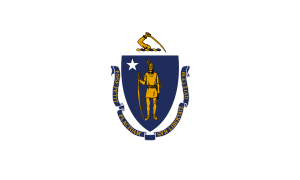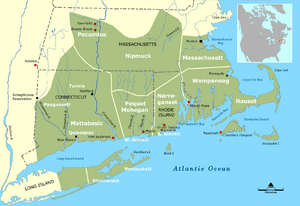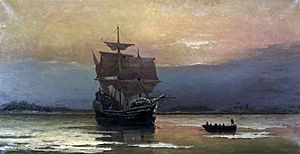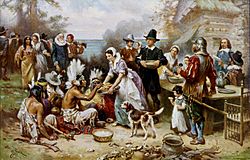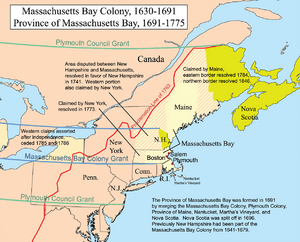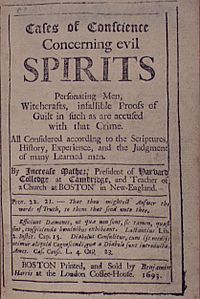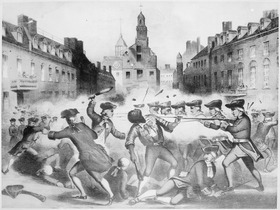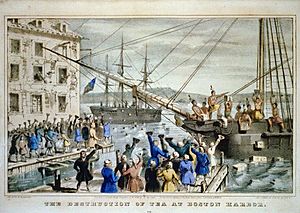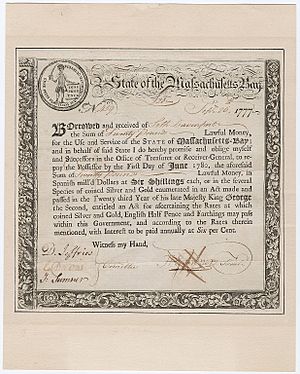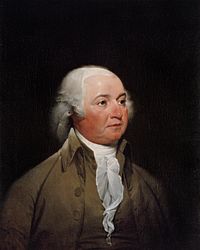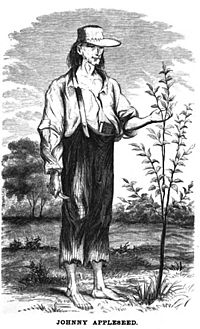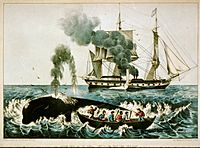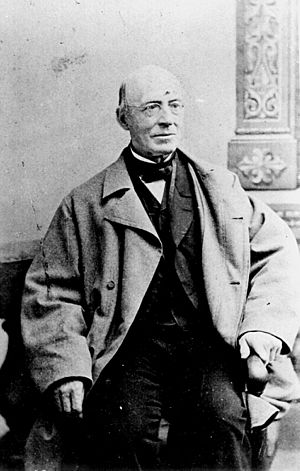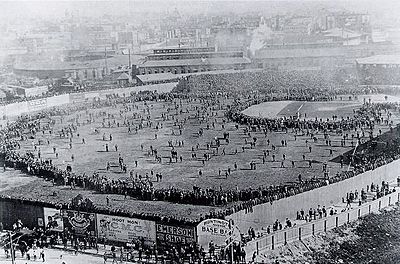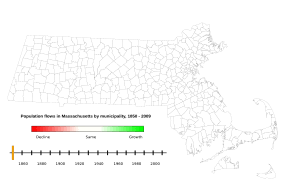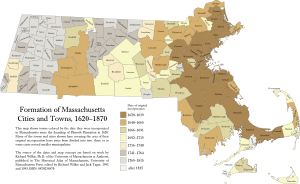History of Massachusetts facts for kids
Massachusetts was first colonized by principally English Europeans in the early 17th century, and became the Commonwealth of Massachusetts in the 18th century. Prior to English colonization of the area, it was inhabited by a variety of mainly Algonquian language indigenous tribes. The first permanent English settlement in New England came in 1620 with the founding of Plymouth Colony by the Pilgrims who sailed on the Mayflower. It set precedents but never grew large. A large-scale Puritan migration began in 1630 with the establishment of the Massachusetts Bay Colony, and spawned the settlement of other New England colonies. Friction with the natives erupted in the high-casualty King Philip's War in the 1670s. Puritanism was the established religion and was strictly enforced; dissenters were exiled. The Colony clashed with Anglican opponents in England over its religious intolerance and the status of its charter. Most people were farmers. Businessmen established wide-ranging trade links, sending ships to the West Indies and Europe, and sometimes shipping goods in violation of the Navigation Acts. These political and trade issues led to the revocation of the Massachusetts charter in 1684.
The king in 1686 established the Dominion of New England to govern all of New England to centralize royal control and weaken local government. The intensely unpopular rule by Sir Edmund Andros came to a sudden end in 1689 with an uprising sparked by the Glorious Revolution in England. The new king William III established the Province of Massachusetts Bay in 1691, to govern a territory roughly equivalent to that of the modern state and Maine. Its governors were appointed by the crown, in contrast to the predecessor colonies, which had elected their own governors. This created friction between the colonists and the crown, which reached its height in the early days of the American Revolution in the 1760s and 1770s over issues of who could levy taxes. Massachusetts was where the American Revolutionary War began in 1775 when London tried to shut down local self-government.
The commonwealth formally adopted the state constitution in 1780, electing John Hancock its first governor. The state was the first to abolish slavery in 1783. In the 19th century Massachusetts became America's center of manufacturing, with the development of precision manufacturing and weaponry in Springfield, and large-scale textile mill complexes in Worcester, Haverhill, Lowell, and other communities using their rivers for power. It was a major intellectual center and center of abolitionism. The Springfield Armory made most of the weaponry for the Union in the American Civil War. After the war, immigrants from Europe flooded into the state, continuing to expand its industrial base until the 1950s, when textiles and other industries started to fade away, leaving a "rust belt" of empty mills and factories. Labor unions were important after the 1860s, as were big city political machines. The state's strength as a center of education contributed to the development of an economy based on information technology and biotechnology in the later years of the 20th century, leading to the "Massachusetts Miracle" of the late 1980s.
Contents
- Before European settlement
- Europeans: Pilgrims and Puritans: 1620–1629
- Massachusetts Bay Colony period: 1628–1686
- Dominion of New England: 1686–1692
- Royal Province of Massachusetts Bay: 1692–1774
- Revolutionary Massachusetts: 1760s–1780s
- Federalist Era: 1780–1815
- Early industrial period: 1815–1860
- Civil War and Gilded Age: 1860–1900
- Prosperity decades: 1900–29
- Depression and war: 1929–1945
- Economic changes: decline of manufacturing 1945–1985
- The Kennedy family
- Modern economy and society: 1985–present
- Boundaries
- Images for kids
Before European settlement
Massachusetts was originally inhabited by tribes of the Algonquian language family such as the Wampanoag, Narragansett, Nipmuc, Pocomtuc, Mahican, and Massachusett. The Algonquian tribes inhabited the area prior to European settlement. In the Massachusetts Bay area resided the Massachusett people. Near the present Vermont and New Hampshire borders and the Merrimack River valley was the traditional home of the Pennacook tribe. Cape Cod, Nantucket, Martha's Vineyard, and southeast Massachusetts were the home of the Wampanoag, whom the Pilgrims met. The extreme end of the Cape was inhabited by the closely related Nauset tribe. Much of the central portion and the Connecticut River valley was home to the loosely organized Nipmuc peoples. The Berkshires were the home of both the Pocomtuc and the Mahican tribes. Spillovers of Narragansett and Mohegan from Rhode Island and Connecticut, respectively, were also present.
Although cultivation of crops like squash and corn supplemented their diets, these tribes were generally dependent on hunting, gathering and fishing for most of their food supply. Villages consisted of lodges called wigwams as well as long houses, and tribes were led by male or female elders known as sachems.
Europeans began exploring the coast of North America in the 16th century, but few attempts were made at permanent settlement anywhere. Early European explorers of the New England coast included the Englishman Bartholomew Gosnold (who named Cape Cod in 1602), Frenchman Samuel de Champlain (who charted the northern coast as far as Cape Cod in 1605 and 1606), and the Englishmen John Smith and Henry Hudson. Fishing ships from Europe also worked in the fish-rich waters off the coast, and may have engaged in trade with some of the natives. The sailors and fishermen brought European diseases which led to the rapid decline of the Indian population before the first large-scale arrival of settlers in the 1630s. Large numbers of natives were decimated by virgin soil epidemics such as smallpox, measles, influenza, and perhaps leptospirosis, against which they had no immunity. In 1617–1619, smallpox killed 90% of the Native Americans in the region.
Europeans: Pilgrims and Puritans: 1620–1629
The first English settlers in Massachusetts, the Pilgrims, established their settlement at Plymouth in 1620, and developed friendly relations with the native Wampanoag. This was the second successful permanent English colony in North America, after the Jamestown Colony. Before heading to the New World, they migrated to Holland to escape the harsh treatment from King James for rejecting England's official church. Although they were allowed some religious liberties in Holland, the liberalism and openness of the Dutch to all styles of life horrified them. They approached the Virginia Company and asked to settle "as a distinct body of themselves" in America. In the fall of 1620, they sailed to North America on the Mayflower, first landing near the tip of Cape Cod (modern-day Provincetown, Massachusetts). Blown north off its course, the Mayflower landed at a site that had been named Plymouth. Since the area was not land that lay within their charter, they created the Mayflower Compact, one of America's first documents of self-governance, prior to landing. The first year was extremely difficult, with inadequate supplies. They also suffered grievously from smallpox and malaria. They were assisted, however, in their time of trouble by the Wampanoag under-chief Massasoit.
In 1621 (following the one held at Berkeley Plantation in Virginia, 1619), they celebrated their first Thanksgiving Day together to thank God for blessings of good harvest and survival. This Thanksgiving came to represent the peace that existed at that time between the Native Americans and the Pilgrims. Although only about half of the Mayflower company survived the first year, the colony grew slowly over the next ten years, and was estimated to have 300 inhabitants by 1630.
The Plymouth colonists were joined by a colony of adventurers that settled nearby at present-day Weymouth in 1622. This colony was short-lived, and abandoned in 1623, only to be replaced by another small colony led by Robert Gorges. This settlement also failed, and individuals from these colonies either returned to England, joined the Plymouth colonists, or established individual outposts elsewhere on the shores of Massachusetts Bay. In 1624 the Dorchester Company established a settlement on Cape Ann. This colony only survived until 1626, but again, a few settlers remained behind.
Massachusetts Bay Colony period: 1628–1686
The Pilgrims were followed by Puritans who established the Massachusetts Bay Colony at present-day Salem (1629) and Boston (1630). The Puritans, who believed the Church of England was too hierarchical (among other disagreements) came to Massachusetts for religious freedom, although, like the Plymouth colony, the bay colony was founded under a royal charter. The Puritans were mainly from East Anglia and southwestern regions of England. With an estimated 20,000 migrants between 1628 and 1642, the Massachusetts Bay colony eclipsed Plymouth in population and economy, the chief factors being more suitable harbor facilities for trade and the growth of a prosperous merchant class.
Both religious dissension and expansionism resulted in several new colonies being founded shortly after Plymouth and Massachusetts Bay. Dissenters such as Anne Hutchinson and Roger Williams were banished due to religious disagreements with Massachusetts Bay authorities; (Hutchinson held meetings in her home discussing flaws in the Puritan beliefs, while Williams believed that the Puritan beliefs were wrong, and the Indians must be respected.) In 1636, Williams founded the colony of Rhode Island and Hutchinson joined him there two years later. Others, such as John Wheelwright, objecting to the religious rule in Massachusetts Bay moved north, joining existing small settlements or establishing new ones in present-day Maine and New Hampshire.
On settling beside the Connecticut River for the first time in 1633 – and for centuries following – Englishmen referred to it simply as "The Great River," because its length and breadth made English rivers like the Mersey, Thames, and Avon all seem like small streams by comparison. (The Connecticut River is approximately twice as long as England's Thames.)
In 1636, a group of settlers led by the Massachusetts Bay Colony's assistant treasurer, William Pynchon founded Springfield, Massachusetts, after first scouting the region's most advantageous location for trading and farming. To Pynchon's surprise, it had not yet been settled. "Agawam," as Springfield was originally called, is located just north of the Connecticut River's first falls that are unnavigable by seagoing vessels. It also sits amidst the fertile valley that contains New England's best agricultural land and lies equidistant to the ports of Boston and Albany. Unlike the three settlements south of Springfield at the time – Windsor, Hartford, and Wethersfield, Connecticut – the Natives surrounding Springfield were friendly. In 1640, Pynchon annexed Springfield to the Massachusetts Bay Colony rather than the Connecticut Colony, because he believed that Connecticut's harsh policies toward the Natives were bad for both business and survival. Thus in 1640, with the annexation of Springfield, the Massachusetts Bay Colony's southern and western borders were established.
In 1636 all of the New England colonies went to war with the Pequot of southeastern Connecticut, practically wiping them out. In 1646 the Long Parliament gave the missionary John Eliot a commission and funds to preach to the Wampanoags. He succeeded in converting a large number. The colonial government placed the converted Indians (known as Praying Indians) in a ring of villages around Boston as a defensive strategy. The oldest such village, Natick, was built in 1651.
The Puritans came to Massachusetts to establish a society according to their religious principles. They were not tolerant of religious views significantly different from their own. Quakers, Baptists, and other religious Nonconformists were banned, and in 1660 four Quakers were hanged on Boston Common. In addition to the banished Anne Hutchinson and Roger Williams, Thomas Hooker left Massachusetts because of the Puritans' lack of religious tolerance, founding the Connecticut Colony.
King Philip's War
Racial tensions led to King Philip's War (1675–76), the bloodiest Indian war of the early colonial period. There were major campaigns in the Pioneer Valley and Plymouth. Starting in the 1670s, Massachusetts followed the general colonial practice of adopting slave codes, which removed the limitation on the term of slavery for non-whites only. It became fashionable for respectable families to own one or more household slaves as cooks or butlers.
King Philip's War was the single greatest calamity ever to occur in seventeenth-century Puritan New England. In little over a year, nearly half of the region's towns were attacked – the major settlements at Providence, Rhode Island and Springfield, Massachusetts were both burned to the ground. (See: the Attack on Springfield.) New England's economy was all but ruined, and much of its population was killed. Proportionately, it was one of the bloodiest and costliest wars in the history of North America.
Economy
Due to persistent shortages of hard currency, the Massachusetts Bay government established a mint, producing a colonial paper currency, the Massachusetts pound, beginning in 1652.
In 1645 the General Court ordered rural towns to increase sheep production. Sheep provided meat and especially wool for the local cloth industry, and reduced the expense of imports of British cloth. The program was a success as many towns increased grazing lands, protected sheep, and saw larger and larger flocks.
Following the restoration of Charles II to the throne in 1660, government practices in the colonies came under more scrutiny. Parliament passed the Navigation Acts to regulate trade for the benefit of the mother country. Massachusetts, with a thriving merchant fleet, often ran afoul of the trade regulations. Its government was reluctant to enforce them. Combined with intolerant religious practices, and the refusal to allow the Church of England to operate in the colony, led Charles II to formally vacate the Massachusetts charter in 1684.
Dominion of New England: 1686–1692
In 1660, King Charles II was restored to the throne. Colonial matters brought to his attention led him to propose the amalgamation of all of the New England colonies into a single administrative unit. In 1685 he was succeeded by James II, an outspoken Catholic who implemented the proposal. In June 1684, the charter of the Massachusetts Bay Colony was annulled, but its government continued to rule until James appointed Joseph Dudley to the new post of President of New England in 1686. Dudley established his authority later in New Hampshire and the King's Province (part of current Rhode Island), maintaining this position until Sir Edmund Andros arrived to become the Royal Governor of the Dominion of New England. The rule of Andros was unpopular. He ruled without a representative assembly, vacated land titles, restricted town meetings, enforced the Navigation Acts, and promoted the Church of England, angering virtually every segment of Massachusetts colonial society. Andros dealt a major blow to the colonists by challenging their title to the land; unlike England the great majority of New Englanders were land-owners. Taylor says that because they "regarded secure real estate as fundamental to their liberty, status, and prosperity, the colonists felt horrified by the sweeping and expensive challenge to their land titles."
After James II was overthrown by King William and Queen Mary in late 1688, Boston colonists overthrew Andros and his officials in 1689. Both Massachusetts and Plymouth returned to their previous governments until 1692. During King William's War (1689–1697), the colony launched an unsuccessful expedition against Quebec under Sir William Phips in 1690, which had been financed by issuing paper bonds set against the gains expected from taking the city. The colony continued to be on the front lines of the war, and experienced widespread French and Indian raids on its northern and western frontiers.
Royal Province of Massachusetts Bay: 1692–1774
In 1691, William and Mary chartered the Province of Massachusetts Bay, combining the territories of Massachusetts Bay, Plymouth, Maine, Nova Scotia (which then included New Brunswick), and the islands south of Cape Cod. For its first governor they chose Sir William Phips. Phips came to Boston in 1692 to begin his rule, and was immediately thrust into the witchcraft hysteria in Salem. He established the court that heard the notorious Salem witch trials, and oversaw the war effort until he was recalled in 1694.
Economy
The province was the largest and most economically important in New England, and one where many American institutions and traditions were formed. Unlike southern colonies, it was built around small towns rather than scattered farms. The westernmost portion of Massachusetts, the Berkshires, were settled during the three decades following the end of the French and Indian War, largely by Scots. Sir Francis Bernard, the Royal Governor, named this new area..."Berkshire", in honor of his home county in England. The largest settlement in Berkshire County was Pittsfield, Massachusetts, founded in 1761.
The educational system, headed by Harvard College, was the best in the 13 colonies. Newspapers became a major communications system in the 18th century, with Boston taking a leading role in the British colonies. Teenaged Benjamin Franklin (born on January 17, 1706 in Milk Street) worked on one of the earliest newspapers, The New-England Courant (owned by his brother) until he ran away to Philadelphia in 1723. Five Boston newspapers presented a full range of opinions during the coming of the American revolution. In Worcester, printer Isaiah Thomas made the Massachusetts Spy the influential voice of the western settlers.
Farming was the largest economic activity. Most farming towns were largely self-sufficient, with families trading with each other for items they did not produce themselves; the surplus was sold to cities. and Fishing was important in coastal towns like Marblehead. Great quantities of cod were exported to the slave colonies in the West Indies. Merchant trade was based in Salem and Boston, with numerous wealthy merchants engaged in worldwide trade; they typically stationed sons and nephews as their agents based in ports around the empire. Their business grew dramatically after 1783 when they no longer were confined to the British Empire. Shipbuilding was a fast-growing industry. Most other manufactured products were imported from Britain (or smuggled in from the Netherlands).
Banking
In 1690, the Massachusetts Bay Colony became the first to issue paper money in what would become the United States, but soon others began printing their own money as well. The demand for currency in the colonies was due to the scarcity of coins, which had been the primary means of trade. Colonies' paper currencies were used to pay for their expenses, as well as a means to lend money to the colonies' citizens. Paper money quickly became the primary means of exchange within each colony, and it even began to be used in financial transactions with other colonies. However, some of the currencies were not redeemable in gold or silver, which caused them to depreciate. The Currency Act of 1751 set limits on the issuance of Bills of Credit by the New England states and set requirements for the redemption of any bills issued. This Act was in response to the overissuance of bills by Rhode Island, eventually reducing their value to 1/27 of the issuing value. The Currency Act of 1764 completely banned the issuance of Bills of Credit (paper money) in the colonies and the making of such bills legal tender because their depreciation allowed the discharge of debts with depreciated paper at a rate less than contracted for, to the great discouragement and prejudice of the trade and commerce of his Majesty's subjects. The ban proved extremely harmful to the economy of the colonies and inhibited trade, both within the colonies and abroad.
The colony was always short of gold and silver and printed a great deal of paper money, which caused inflation that favored farmers but angered business interests. By 1750, however, the colony recalled its paper currency and transitioned to a specie currency based on the British reimbursement (in gold and silver) for its spending in the French and Indian wars. The large-scale merchants and Royal officials welcomed the transition but many farmers and smaller businessmen were opposed.
Wars with France
The colony fought alongside British regulars in a series of French and Indian Wars that were characterized by brutal border raids and attacks by Indians organized and supplied by New France. Particularly in King William's War (1689–97) and Queen Anne's War (1702–13), the colony's rural communities were directly exposed to French and Indian attacks, with Deerfield raided in 1704 and Haverhill raided in 1708. Boston responded, launching naval expeditions against Acadia and Quebec in both wars.
During Queen Anne's War, Massachusetts men were involved in the Conquest of Acadia (1710), which became the Province of Nova Scotia. The province was also involved in Dummer's War, in which Indian tribes were driven from northern New England. In 1745, during King George's War, Massachusetts provincial forces successfully besieged Fortress Louisbourg. The fortress was returned to France at the end of the war, angering many colonists who viewed it as a threat to their security. During the French and Indian War, Governor William Shirley was instrumental in the Expulsion of the Acadians from Nova Scotia and trying to settle them in New England. After the expulsion, Shirley also was involved in transporting New England Planters to settle Nova Scotia on the former Acadian farms. Many troops from Massachusetts participated in the successful Siege of Havana in 1762. Britain's victory in the war led to its acquisition of New France, removing the immediate northern threat to Massachusetts that the French had posed.
Disasters
Boston was hit by a major smallpox epidemic in 1721. Some colonial leaders called for use of the new technique of inoculation, whereby a patient would get a weak form of the disease and become permanently immune. Puritan minister Cotton Mather and physician Zabdiel Boylston led the drive for inoculation, while physician William Douglass and newspaper editor James Franklin led the opposition.
In 1755, about 4:15 am on Tuesday, November 18, was the most destructive earthquake yet known in New England. The first pulsations of the ground were followed for about a minute of tremulous motion. Next came a quick vibration and several jerks much worse than the first. Houses rocked and cracked; furniture fell over. Dr. Edward A. Holyoke, of Salem, wrote in his diary that he "thought of nothing less than being buried instantly in the ruins of the house." The shaking continued for two to three minutes more, and seemed to move from northwest to southeast. The ocean along the coast was affected; ships shook so much that sleeping sailors awoke, thinking they had run aground. In Boston, the earthquake threw dishes on the floor, stopped clocks, and bent vane-rods on churches and Faneuil Hall. Stone walls collapsed. New springs appeared, and old springs dried up. Subterranean streams changed their courses, emptying many wells. The worst damage was to chimneys. In Boston alone, about a hundred were leveled; about fifteen hundred were damaged, the streets in some places almost covered with fallen bricks. Falling chimneys broke some roofs. Many wooden buildings in Boston were thrown down, and some brick buildings suffered; the gable ends of twelve or fifteen were knocked down to the eaves. Despite the danger and many narrow escapes, no one was killed or seriously injured. Aftershocks continued for four days.
Politics
The relationship between the provincial government and the crown-appointed governor was often difficult and contentious. The governors sought to assert the royal prerogatives granted in the provincial charter, and the provincial government sought to strip or minimize the governor's power. For example, each governor was ordered to enact legislation for providing permanent salaries for crown officials, but the legislature refused to do so, using its ability to grant stipends annually as a means of control over the governor. The province's periodic issuance of paper currency was also a persistent source of friction between factions in the province, due to its inflationary effects. Notable royal governors during this period were Joseph Dudley, Thomas Hutchinson, Jonathan Belcher, Francis Bernard, and General Thomas Gage. Gage was the last British governor of Massachusetts, and his effective rule extended to little more than Boston.
Revolutionary Massachusetts: 1760s–1780s
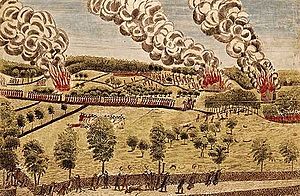
Massachusetts was a center of the movement for independence from Great Britain, earning it the nickname, the "Cradle of Liberty". Colonists here had long had uneasy relations with the British monarchy, including open rebellion under the Dominion of New England in the 1680s. The Boston Tea Party is an example of the protest spirit in the early 1770s, while the Boston Massacre escalated the conflict. Anti-British activity by men like Sam Adams and John Hancock, followed by reprisals by the British government, were a primary reason for the unity of the Thirteen Colonies and the outbreak of the American Revolution. The Battles of Lexington and Concord initiated the American Revolutionary War and were fought in the Massachusetts towns of Lexington and Concord. Future President George Washington took over what would become the Continental Army after the battle. His first victory was the Siege of Boston in the winter of 1775–6, after which the British were forced to evacuate the city. The event is still celebrated in Suffolk County as Evacuation Day. In 1777, George Washington and Henry Knox founded the Arsenal at Springfield, which catalyzed many innovations in Massachusetts' Connecticut River Valley.
Boston Massacre
Boston was the center of revolutionary activity in the decade before 1775, with Massachusetts natives Samuel Adams, John Adams, and John Hancock as leaders who would become important in the revolution. Boston had been under military occupation since 1768. When customs officials were attacked by mobs, two regiments of British regulars arrived. They had been housed in the city with increasing public outrage.
In Boston on March 5, 1770, what began as a rock-throwing incident against a few British soldiers ended in the shooting of five men by British soldiers in what became known as the Boston Massacre. The incident caused further anger against British authority in the commonwealth over taxes and the presence of the British soldiers.
Boston Tea Party
One of the many taxes protested by the colonists was a tax on tea, imposed when Parliament passed the Townshend Acts, and retained when most of the provisions of those acts were repealed. With the passage of the Tea Act in 1773, tea sold by the British East India Company would become less expensive than smuggled tea, and there would be reduced profitmaking opportunities for Massachusetts merchants engaged in the tea trade. This led to protests against the delivery of the company's tea to Boston. On December 16, 1773, when a tea ship of the East India Company was planning to land taxed tea in Boston, a group of local men known as the Sons of Liberty sneaked onto the boat the night before it was to be unloaded and dumped all the tea into the harbor, an act known as the Boston Tea Party.
American Revolution
The Boston Tea Party prompted the British government to pass the Intolerable Acts in 1774 that brought stiff punishment on Massachusetts. They closed the port of Boston, the economic lifeblood of the Commonwealth, and reduced self-government. Local self-government was ended and the colony put under military rule. The Patriots formed the Massachusetts Provincial Congress after the provincial legislature was disbanded by Governor Gage. The suffering of Boston and the tyranny of its rule caused great sympathy and stirred resentment throughout the Thirteen Colonies. On February 9, 1775, the British Parliament declared Massachusetts to be in rebellion, and sent additional troops to restore order to the colony. With the local population largely opposing British authority, troops moved from Boston on April 18, 1775, to destroy the military supplies of local resisters in Concord. Paul Revere made his famous ride to warn the locals in response to this march. On the 19th, in the Battles of Lexington and Concord, where the famous "shot heard 'round the world" was fired, British troops, after running over the Lexington militia, were forced back into the city by local resistors. The city was quickly brought under siege. Fighting broke out again in June when the British took the Charlestown Peninsula in the Battle of Bunker Hill after the colonial militia fortified Breed's Hill. The British won the battle, but at a very large cost, and were unable to break the siege. The British made a desperate attempt by using biological weapons against the Americans by sending infected civilians with smallpox behind American lines but this was soon contained by Continental General George Washington who launched a vaccination program to ensure his troops and civilians were in good health after the damage biological warfare caused. Soon after the Battle of Bunker Hill, General George Washington took charge of the rebel army, and when he acquired heavy cannon in March 1776, the British were forced to leave, marking the first great colonial victory of the war. Ever since "Evacuation Day" has been celebrated as a state holiday.
Massachusetts was not invaded again but in 1779 the disastrous Penobscot Expedition took place in the District of Maine, then part of the Commonwealth. Trapped by the British fleet, the American sailors sank the ships of the Massachusetts state navy before it could be captured by the British. In May 1778, the section of Freetown that later became Fall River was raided by the British, and in September 1778, the communities of Martha's Vineyard and New Bedford were also subjected to a British raid.
John Adams was a leader in the independence movement and he helped secure a unanimous vote for independence and on July 4, 1776, the United States Declaration of Independence was adopted in Philadelphia. It was signed first by Massachusetts resident John Hancock, president of the Continental Congress. Soon afterward the Declaration of Independence was read to the people of Boston from the balcony of the State House. Massachusetts was no longer a colony; it was a state and part of a new nation, the United States of America.
Federalist Era: 1780–1815
A Constitutional Convention drew up a state constitution, which was drafted primarily by John Adams, and ratified by the people on June 15, 1780. Adams, along with Samuel Adams and James Bowdoin, wrote in the Preamble to the Constitution of the Commonwealth:
We, therefore, the people of Massachusetts, acknowledging, with grateful hearts, the goodness of the Great Legislator of the Universe, in affording us, in the course of His Providence, an opportunity, deliberately and peaceably, without fraud, violence or surprise, on entering into an Original, explicit, and Solemn Compact with each other; and of forming a new Constitution of Civil Government, for Ourselves and Posterity, and devoutly imploring His direction in so interesting a design, Do agree upon, ordain and establish, the following Declaration of Rights, and Frame of Government, as the Constitution of the Commonwealth of Massachusetts.
Bostonian John Adams, known as the "Atlas of Independence", was an important figure in both the struggle for independence as well as the formation of the new United States. Adams was highly involved in the push for separation from Britain and the writing of the Massachusetts Constitution in 1780 (which, in the Elizabeth Freeman and Quock Walker cases, effectively made Massachusetts the first state to have a constitution that declared universal rights and, as interpreted by Supreme Judicial Court Chief Justice William Cushing, abolished slavery). Adams became minister to Britain in the 1780s, Vice President in 1789 and succeeded Washington as President in 1797. His son, John Quincy Adams, would go on to become the sixth US President.
The new constitution
Massachusetts was the first state to abolish slavery. The new constitution also dropped any religious tests for political office, though local tax money had to be paid to support local churches. People who belonged to non-Congregational churches paid their tax money to their own church, and the churchless paid to the Congregationalists. Baptist leader Isaac Backus vigorously fought these provisions, arguing people should have freedom of choice regarding financial support of religion. Adams drafted most of the document and despite numerous amendments it still follows his line of thought. He distrusted utopians and pure democracy, and put his faith in a system of checks and balances; he admired the principles of the unwritten British Constitution. He insisted on a bicameral legislature which would represent both the gentlemen and the common citizen. Above all he insisted on a government by laws, not men. The constitution also changed the name of the Massachusetts Bay State to the Commonwealth of Massachusetts. Still in force, it is the oldest constitution in current use in the world.
Shays' Rebellion

The economy of rural Massachusetts suffered an economic depression after the war ended. Merchants, pressured for hard currency by overseas partners, made similar demands on local debtors, and the state raised taxes in order to pay off its own war debts. Efforts to collect both public and private debts from cash-poor farmers led to protests that flared into direct action in August 1786. Rebels calling themselves Regulators (after the North Carolina Regulator movement of the 1760s) succeeded in shutting down courts meeting to hear debt and tax collection cases. By the end of 1786 a farmer in western Massachusetts named Daniel Shays emerged as one of the ringleaders, and government attempts to squelch the protests only served to radicalize the protestors. In January 1787 Shays and Luke Day organized an attempt to take the federal Springfield Armory; state militia holding the armory beat back the attempt with cannon fire. A private militia raised by wealthy Boston merchants and led by General Benjamin Lincoln broke the back of the rebellion in early February at Petersham, but small-scale resistance continued in the western parts of the state for a while.
The state put down the rebellion—but if it had been too weak to do so it would be no help to call on the ineffective federal government. The event led nationalists like George Washington to redouble efforts to strengthen the weak national government as necessary for survival in a dangerous world. Massachusetts, divided along class lines polarized by the rebellion, only narrowly ratified the United States Constitution in 1788.
Folk Hero
John Chapman often called Johnny "Appleseed" (born on September 26, 1774, in Leominster, Massachusetts) was an American folk hero and pioneer nurseryman who introduced apple trees and established orchards to many areas in the Midwestern region of the country including Pennsylvania, Ohio, and Indiana. Today, Appleseed is the official folk hero of Massachusetts and his stature has served a focus in many children's books, movies, and folk tales since the end of the Civil War.
Early industrial period: 1815–1860
In 1836, Mary Lyon opened Mount Holyoke College, the first women's college in America. Lyon, a very active Congregationalist, promoted the college as an exemplification of the ideas of revivalist Jonathan Edwards regarding self-restraint, self-denial, and disinterested benevolence. One of the first students was reclusive poet Emily Dickinson.
During the 19th century, Massachusetts became a national leader in the American Industrial Revolution, with factories around Boston producing textiles and shoes, and factories around Springfield producing precision manufacturing tools and paper. The economy transformed from one based primarily on agriculture to an industrial one, initially making use of waterpower and later the steam engine to power factories, and canals and later railroads for transporting goods and materials. At first, the new industries drew labor from Yankees on nearby subsistence farms, and later relied upon Catholic immigrants from Ireland and Canada.
Industrial development
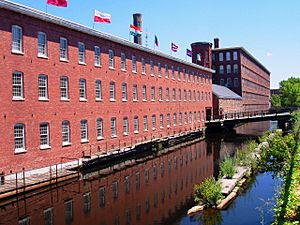
Massachusetts became a leader in industrial innovation and development during the 19th century. Since colonial times, there had been a successful iron making industry in New England. The first successful ironworks in America was established at Saugus in 1646, utilizing bog iron from swamps to produce plows, nails, firearms, hoops for barrels and other items necessary for the development of the Colony. Other industries would be established during this period, such as shipbuilding, lumber, paper and furniture making. These small-scale shops and factories often utilized the State's many rivers and streams to power their machinery.
While Samuel Slater had established the first successful textile mill at Pawtucket, Rhode Island in 1793, there remained no way to efficiently mass-produce cloth from the spun yarn produced by the early mills. The yarn was still outsourced to small weaving shops where it was woven into cloth on hand looms. The first woolen mill, and the second textile mill in the Blackstone Valley, was a "wool carding mill", established in 1810 by Daniel Day, near the West River and Blackstone River at Uxbridge, Massachusetts. Then, in 1813, a group of wealthy Boston merchants led by Francis Cabot Lowell, known as the Boston Associates, established the first successful integrated textile mill in North America at Waltham. Lowell had visited England in 1810 and studied the Lancashire textile industry. Because the British government prohibited the export of this new technology, Lowell memorized plans for the power looms on his return trip to Boston. With the skill of master mechanic Paul Moody, the first successful power looms were produced, harnessing the power of the Charles River. For the first time, all phases of textile production could now be performed under one roof, greatly increasing production, and profits. This was the real beginning of the Industrial Revolution in America.
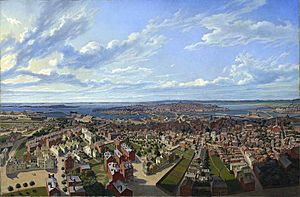
With the early success of the Boston Manufacturing Company at Waltham, the Boston Associates would also later establish several other textile towns, including Lowell in 1823, Lawrence in 1845, Chicopee in 1848 and Holyoke in 1850.
Lowell grew quickly to a city of 33,000 people by 1850. Its mills were highly integrated and centrally controlled. An ingenious canal system provided the water power that drove the machinery. Steam power would be introduced beginning in the 1850s. The mill owners initially employed local farm women, often recruited from poor, remote parts of New England, and attempted to create a Utopian industrial society by providing housing, churches, schools and parks for their workers, unlike their English counterparts. Eventually, as the mills grew larger and larger, the owners turned to newly arrived Irish immigrants to fill their factories.
Industrial cities, especially Worcester and Springfield, became important centers in textile machinery (in Worcester's case) and precision tool production and innovation (in Springfield's case.) While Boston did not have many large factories, it became increasingly important as the business and transportation hub of all of New England, as well as a national leader in finance, law, medicine, education, arts and publishing.
Railroads
In 1826, the Granite Railway became the first commercial railroad in the nation. In 1830 the legislature chartered three new railroads—the Boston and Lowell, the Boston and Providence, and most important of all, the Boston and Worcester. In 1833 it chartered the Western Railroad to connect Worcester with Albany and the Erie Canal. The system flourished and western grain began flowing to the port of Boston for export to Europe, thereby breaking New York City's virtual monopoly on trade from the Erie Canal system. Much of the construction work was done by Irish Catholic work gangs. They lived in temporary camps but many settled in the new industrial cities along the line, where the gang bosses became leaders in the Democratic Party. Some of their work is still in use. For example, the stone Canton Viaduct at Canton, Massachusetts, built in 1835, is still in use by Amtrak's high-speed Acela Express along the Boston–Washington, Northeast Corridor. The viaduct required only minor changes to bring it up to late-20th-century standards.
Whaling
Beginning in the late colonial period, Massachusetts leveraged its strong seafaring tradition, advanced shipbuilding industry, and access to the oceans to make the U.S. the pre-eminent whaling nation in the world by the 1830s. Whale oil was in demand chiefly for lamps. By the 1750s whaling in Nantucket had become a highly lucrative deep-sea industry, with voyages extending for years at a time and with vessels traveling as far as South Pacific waters. The British Navy captured most of the whalers during the revolution, but at the same time many whalers refitted out as privateers against the British. Whaling recovered after the war as New Bedford became the center. Whalers took greater economic risks to turn major profits: expanding their hunting grounds and securing foreign and domestic workforces for the Pacific. Investment decisions and financing arrangements were set up so that managers of whaling ventures shared their risks by selling some equity claims but retained a substantial portion due to moral hazard considerations. As a result, they had little incentive to consider the correlation between their own returns and those of others in planning their voyages. This stifled diversity in whaling voyages and increased industry-wide risk. After 1860 kerosene replaced whale oil—concurrent with the devastation of the whaling fleet by Confederate commerce raiders—and the entrepreneurs shifted to manufacturing.
Political and social movements
On March 15, 1820, Maine was separated from Massachusetts and entered the Union as the 23rd State as a result of the enactment of the Missouri Compromise.
Horace Mann made the state system of schools the national model. The Commonwealth made its mark in Washington with such political leaders as Daniel Webster and Charles Sumner. Building on the many activist Congregational churches, abolitionism flourished. William Lloyd Garrison was the outstanding spokesperson, though many "cotton Whig" mill owners complained that the agitation was bad for their strong business ties to southern cotton planters.
The Congregationalists remained dominant in rural areas, but, in the cities, a new religious sensibility had replaced their strait-laced Calvinism. By 1826, reported Harriet Beecher Stowe:
All the literary men of Massachusetts were Unitarians. All the trustees and professors of Harvard College were Unitarians. All the élite of wealth and fashion crowded Unitarian churches. The judges on the bench were Unitarian, giving decisions by which the peculiar features of church organization, so carefully ordained by the Pilgrim fathers, had been nullified.
Some of the most important writers and thinkers of this time came from Massachusetts. Henry David Thoreau and Ralph Waldo Emerson are well known today for their contributions to American thought. Part of an intellectual movement known as Transcendentalism, they emphasized the importance of the natural world to humanity and were also part of the abolitionist call.
Know Nothing movement
The Know Nothing movement formed a new party in 1854 and captured almost all the seats in the legislature, the state government, and many cities. Historian John Mulkern finds the new party was populist and highly democratic, hostile to wealth, elites, and to expertise, and deeply suspicious of outsiders especially Catholics. The new party's voters were concentrated in the rapidly growing industrial towns, where Yankee workers faced direct competition with new Irish immigrants. Whereas the Whig party was strongest in high income districts, the Know Nothing electorate was strongest in the poor districts. They voted out the traditional upper-class closed political leadership class, especially the lawyers and merchants. In their stead they elected working class men, farmers, and a large number of teachers and ministers. Replacing the moneyed elite were men who seldom owned $10,000 in property.
In national perspective, the most aggressive and innovative legislation came out of Massachusetts, Both in terms of nativism and in terms of reforms. Historian Stephen Taylor says that in addition to nativist legislation:
- the party also distinguished itself by its opposition to slavery, support for an expansion of the rights of women, regulation of industry, and support of measures designed to improve the status of working people.
It passed legislation to regulate railroads, insurance companies, and public utilities. It funded free textbooks for the public schools, and raised the appropriations for local libraries and for the school for the blind. Purification of Massachusetts against divisive social evils was a high priority. The legislature set up the state's first reform school for juvenile delinquents, while trying to block the importation of supposedly subversive government documents and academic books from Europe. It upgraded the legal status of wives, giving them more property rights and more rights in divorce courts. It passed harsh penalties on speakeasies and gambling houses. Many of the reforms were quite expensive; State spending rose 45% on top of a 50% hike in annual taxes on cities and towns. The extravagance angered the taxpayers; few Know Nothings were reelected so the brief two-year experiment ended.
The highest priority included attacks on the civil rights of Irish Catholic immigrants. State courts lost the power to process applications for citizenship; the public schools had to require compulsory daily reading of the Protestant Bible (which the nativists were sure would transform the Catholic children). The governor disbanded the Irish militias, and replaced Catholics holding state jobs with Protestants. It failed to reach the two-thirds vote needed to pass a state constitutional amendment to restrict voting and office holding to men who had resided in Massachusetts for at least 21 years. The legislature then called on Congress to raise the requirement for naturalization from five years to 21 years, but Congress never acted.
Civil War and Gilded Age: 1860–1900
In the years leading up to the Civil War, Massachusetts was a center of social progressivism, Transcendentalism, and abolitionist activity. Horace Mann made the state system of schools the national model. Two prominent abolitionists from the Commonwealth were William Lloyd Garrison and Wendell Phillips. Garrison founded the New England Anti-Slavery Society in 1832, and helped change perceptions on slavery. The movement increased antagonism over the issues of slavery, resulting in anti-abolitionist riots in Massachusetts between 1835 and 1837. The works of abolitionists contributed to the eventual actions of the Commonwealth during the Civil War.
Henry David Thoreau and Ralph Waldo Emerson made major contributions to American thought. Members of the Transcendentalism movement, they emphasized the importance of the natural world and emotion to humanity. Although significant opposition to abolitionism existed early on in Massachusetts, resulting in anti-abolitionist riots between 1835 and 1837, opposition to slavery gradually increased in the next few decades. Famed abolitionist John Brown moved to the ideologically progressive town of Springfield in 1846. It was there that Brown first became a militant anti-slavery proponent. In Springfield and in Boston, Brown met the connections that would both influence him, (Frederick Douglass and Sojourner Truth in Springfield,) and later fund his efforts, (Simon Sanborn and Amos Adams Lawrence in Boston,) in Bleeding Kansas and John Brown's raid on Harpers Ferry. In 1850, Brown founded his first militant, anti-slavery organization – The League of the Gileadites – in Springfield, to protect escaped slaves from 1850's Fugitive Slave Act. Massachusetts was a hotbed of abolitionism – particularly the progressive cities of Boston and Springfield – and contributed to subsequent actions of the state during the Civil War. Massachusetts was among the first states to respond to President Lincoln's call for troops. Massachusetts was the first state to recruit, train and arm a black regiment with white officers, the 54th Massachusetts Volunteer Infantry. Massachusetts was the first state to recruit, train, and arm a Black regiment with White officers, the 54th Massachusetts Volunteer Infantry. The Robert Gould Shaw Memorial in Boston Common contains a relief depicting the 54th regiment. Much of the Union's weaponry for the Civil War was produced in Springfield, at the Springfield Armory.
Following the Civil War, thousands of immigrants from Canada and Europe continued to settle in the major cities of Massachusetts, attracted by employment in the state's ever-expanding factories. The state also became a leader in education and innovation through this period, particularly in the Boston area.
Invention of basketball and volleyball
In 1891 and 1895, the sports of basketball and volleyball—both now Olympic sports, popular worldwide—were invented in the Western Massachusetts cities of Springfield and Holyoke, respectively. Today, Springfield is home to the international Basketball Hall of Fame. Holyoke is home to the international Volleyball Hall of Fame.
Industrial advance
In the 1890s—largely due to the presence of the Springfield Armory, which employed many skilled, mechanical workers—Greater Springfield became the United States' first major center of automobile and motorcycle innovation. The United States' first gasoline-powered automobile company, the Duryea Motor Wagon Company, was founded in Chicopee in 1893. The first American motorcycle company, the Indian Motorcycle Company, was founded in Springfield in 1901. Knox Automobile produced the world's first motorized fire engines in Springfield in 1906.
Although the basic rail system was in place by 1860, the railways continued to make major improvements in tracks, signals, bridging, and facilities. With steel came heavier trains and more powerful locomotives. In the 1880s the Boston & Albany Railroad invested heavily in its physical facilities, including the construction of over 30 new passenger stations. Famed Boston architect H. H. Richardson did much of the design work.
Passenger transportation was revolutionized by the electric trolley. Thomas Davenport demonstrated the feasibility of the electric railway in Springfield in the late 1870s. In 1889 the city's first line was constructed and by 1905 Springfield had more track than New York City. The lines provided rapid, cheap transportation for farm produce and workers, created land booms in suburbia, and permitted Sunday outings in the country. They were highly profitable and the base of numerous fortunes.
Prosperity decades: 1900–29
Massachusetts entered the 20th century with a strong industrial economy. Despite a lack of agricultural progress, the economy prospered between 1900 and 1919. Factories throughout the Commonwealth produced goods varying from paper to metals. Boston, in the year 1900, was still the second most important port in the United States, as well as the most valuable U.S. port in terms of its fish market. By 1908, however, the value of the port dropped considerably due to competition. Population growth during this period, which was aided by immigration from abroad, helped in urbanization and forced a change in the ethnic make-up of the Commonwealth.
The largely industrial economy of Massachusetts began to falter, however, due to the dependence of factory communities upon the production of one or two goods. External low-wage competition, coupled with other factors of the Great Depression in later years, led to the collapse of the state's two main industries: shoes and textiles. Between 1921 and 1949 the failure of those industries resulted in rampant unemployment and the urban decay of once-prosperous industrial centers which would persist for several decades.
The industrial economy began a decline in the early 20th century with the exodus of many manufacturing companies. By the 1920s competition from the South and Midwest, followed by the Great Depression, led to the collapse of the three main industries in Massachusetts: textiles, shoemaking, and mechanized transportation. This decline would continue into the latter half of the century; between 1950 and 1979, the number of Bay Staters involved in textile manufacturing declined from 264,000 to 63,000. The Springfield Armory, the United States' Military's munitions producer since 1777, was controversially shutdown by the Pentagon in 1968. This spurred an exodus of high-paying jobs from Western Massachusetts, which suffered greatly as it de-industrialized during the last 40 years of the 20th century. In Eastern Massachusetts, following World War II, the economy was transformed from one based on heavy industry into a service and high-tech based economy. Government contracts, private investment, and research facilities led to a new and improved industrial climate, with reduced unemployment and increased per capita income. Suburbanization flourished, and by the 1970s, the Route 128 corridor was dotted with high-technology companies who recruited graduates of the area's many elite institutions of higher education.
On Thursday, October 1, 1903, the city of Boston made history by hosting the inaugural World Series at the Huntington Avenue Grounds. The Boston Red Sox won the best-of-nine series and launched into a baseball dynasty in the following years by capturing five championships in fifteen years behind Hall of Famer Babe Ruth.
Depression and war: 1929–1945
Even before the Great Depression struck the United States, Massachusetts was experiencing economic problems. The crash of the Commonwealth's major industries led to declining population in factory towns. The Boston metropolitan area became one of the slowest-growing areas in the United States between 1920 and 1950. Internal migration within the Commonwealth, however, was altered by the Great Depression. In the wake of economic woes, people moved to the metropolitan area of Boston looking for jobs, only to find high unemployment and dismal conditions. In the depressed situation that predominated in Boston during this era, racial tension manifested itself in gang warfare at times, notably with clashes between the Irish and Italians.
Massachusetts also endured class conflict during this period. In the 1912 general strike in Lawrence, almost all of the town's mills were forced to shut down as a result of strife over wages that sustained only poverty. The Commonwealth was confronted with issues of worker conditions and wages. For example, when the legislature decreed that women and children could work only 50 hours per week, employers cut wages proportionally. Eventually, the demands of the Lawrence strikers were heeded, and a pay increase was made.
The economic and social turmoil in Massachusetts marked the beginning of a change in the Commonwealth's way of functioning. Politics helped to encourage stability among social groups by elevating members of various ranks in society, as well as ethnic groups, to influential posts. The two major industries of Massachusetts, shoes and textiles, had declined in a way that even the post-World War II economic boom could not reverse. Thus, the Commonwealth's economy was ripe for change as the post-war years dawned.
Economic changes: decline of manufacturing 1945–1985
World War II precipitated great changes in the economy of Massachusetts, which in turn led to changes in society. The aftermath of WWII created a global economy that was focused upon the interests of the United States, both militarily and in relation to business. The domestic economy in the United States was altered by government procurement policies focused on defense. In the years following WWII, Massachusetts was transformed from a factory-based economy to one based on services and technology. During WWII, the U.S. government had built facilities that they leased, and in the post-war years sold, to defense contractors. Such facilities contributed to an economy focused on creating specialized defense goods. That form of economy prospered as a result of the Cold War, the Vietnam War, and the Korean War.
In the ensuing years, government contracts, private investment, and research facilities helped to create a modern industry, which reduced unemployment and increased per capita income. All of these economic changes encouraged suburbanization and the formation of a new generation of well-assimilated and educated middle-class workers. At the same time, suburbanization and urban decay highlighted differences between various social groups, leading to a renewal of racial tension. Boston, a paragon of the problems in Massachusetts cities, experienced numerous challenges that led to racial problems. The problems facing urban centers included declining population, middle-class flight, departure of industry, high unemployment, rising taxes, low property values, and competition among ethnic groups.
The Kennedy family
The Kennedy family was prominent in Massachusetts politics in the 20th century. Children of businessman and ambassador Joseph P. Kennedy Sr. included John F. Kennedy, who was a senator and US president before his assassination in 1963, Robert F. Kennedy, who was a senator, US attorney general and presidential candidate before his assassination in 1968, Ted Kennedy, a senator from 1962 until his death in 2009, and Eunice Kennedy Shriver, a co-founder of the Special Olympics. The famous Kennedy Compound is located at Hyannisport on Cape Cod.
Modern economy and society: 1985–present
Over the past 20–30 years, Massachusetts has cemented its place in the country as a center of education (especially higher education) and high-tech industry, including the biotechnology and information technology sectors. With better-than-average schools overall and many elite universities, the area was well placed to take advantage of the technology-based economy of the 1990s. The rebound from the decay of manufacturing into the high-technology sector is often referred to as the Massachusetts Miracle.
The Commonwealth had several notable citizens in federal government in the 1980s, including almost presidential hopeful and Senator Ted Kennedy and House Speaker Tip O'Neill. This legislative influence allowed the Commonwealth to receive federal highway funding for the $14.6 billion Boston Central Artery/Tunnel Project. Known colloquially as "the Big Dig", it was, at the time, the most expensive federal highway project ever approved. Designed to relieve some of the traffic problems of the poorly planned city, it was approved in 1987, and effectively completed in 2005. The project was controversial due to massive budget overruns, repeated construction delays, water leaks in the new tunnels in 2004, and a ceiling collapse in 2006 that killed a Bostonian.
Several Massachusetts politicians have run for the office of President of the United States in this period, won the primary elections, and gone on to contest the national elections. These include Michael Dukakis, who was defeated by George H. W. Bush in 1988; John Kerry, who was defeated by George W. Bush in 2004; and Mitt Romney, who was defeated by Barack Obama in 2012.
On November 18, 2003, the Massachusetts Supreme Judicial Court (SJC) decided that the Commonwealth could not deny marriage rights to gay couples under the state constitution. On February 4, 2004, the SJC followed that ruling with a statement saying that allegedly separate but equal civil unions, implemented as of late in Vermont, would not pass constitutional muster and that only full gay marriage rights met constitutional guarantees. On May 17, 2004, the ruling took effect and thousands of gay and lesbian couples across the Commonwealth entered into marriage. Opponents of gay marriage subsequently pushed for an amendment to the state constitution that would allow the state to deny marriage rights to gay couples. It was necessary for the amendment to be approved by at least 1/4 of the members present in two consecutive legislative sessions of the Massachusetts legislature, and to receive majority support in a popular referendum. It passed the first legislative session, but was defeated in the second session, receiving less than 1/4 of the votes of the legislators present. As public opinion polls currently indicate majority support for gay marriage among the people of the Commonwealth, it is likely that the issue is settled in Massachusetts.
Increased white-collar jobs have driven suburban sprawl, but the consequent effects of sprawl have been lessened by regulations on land use and zoning, as well as an emphasis on "smart growth". In recent years, the Commonwealth has lost population as high housing costs have driven many away from Massachusetts. The Boston area is the third most expensive housing market in the country. Over the last several years there has been a net outflow of about 19,000 people from the Commonwealth.
In 2006, the Massachusetts legislature enacted the first plan in the United States to provide all Commonwealth citizens with universal health insurance coverage, using a variety of private insurance providers. Insurance coverage for low-income individuals is paid for with tax revenues, and higher income people who don't have health insurance are required to purchase it. (The health insurance market is publicly regulated, so, at least in Massachusetts, no one can be denied coverage because of pre-existing conditions or be forced to pay exorbitant rates.) The implementation of Commonwealth Care, the new universal coverage law, is proceeding, as of 2007.
The Big Dig
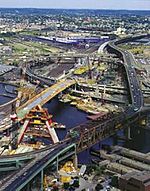
In 1987, the state received federal funding for the Central Artery/Tunnel Project. Known as "the Big Dig", it was at the time the biggest federal highway project ever approved. The project included making the Central Artery a tunnel under downtown Boston, in addition to the re-routing of several other major highways. Often controversial, with numerous claims of graft and mismanagement, and with its initial price tag of $2.5 billion increasing to a final tally of over $15 billion, the Big Dig has nonetheless changed the face of Downtown Boston. It has connected areas that were once divided by elevated highway, (much of the raised old Central Artery was replaced with the Rose Kennedy Greenway) and improved traffic conditions along a number of routes.
Boundaries
The history of the boundaries of Massachusetts is somewhat complex and covers several centuries. Land grants made to various groups of early colonists, mergers and secessions, and settlements of various boundary disputes all had a major influence on the modern definition of the Commonwealth. Disputes arose due to both overlapping grants, inaccurate surveys (creating a difference between where the border "should" be and where markers are placed on the ground). Having loyal settlers actually on the ground also partially determined which portions of their vast claims early groups held on to.
Founding grants
In 1607, the Plymouth Company was granted a coastal charter for all coastal territory up to a certain distance from the eastern shoreline of North America, from 38°N to 45°N. The northern boundary was thus slightly farther north than the current Maine-New Brunswick border, and the southern border intentionally overlapped with the Virginia Company of London ("London Company") from the 38th parallel (near the current Maryland-Virginia border) to the 41st (near the current Connecticut-New York border in Long Island Sound). Neither colony was allowed to settle within 100 miles of the other. The Plymouth Company's patent fell into disuse after the failure of the Popham Colony in what is now Maine. In the meantime, the Plymouth Colony had settled outside the territory of the London company due to navigational difficulties. The Plymouth Company was reorganized as the Plymouth Council for New England, and given a new royal sea-to-sea charter for all North American territory from 40° North (just east between present-day Philadelphia and Trenton, New Jersey) and 48° N (thus including all of modern-day New Brunswick, Nova Scotia, and Prince Edward Island). The Plymouth Colony was granted land patents between 1621 and 1630 from the Council to legitimize its settlement, though it maintained political independence under the Mayflower Compact.
The Plymouth Council for New England made sub grants to various entities before it was surrendered to the crown in 1635 and ceased to operate as a corporate entity.
The Sheffield Patent granted the use of Cape Ann to members of the Plymouth Colony and the Dorchester Company. The fishing colony there failed, but led to the foundation of Salem, Massachusetts. The bankrupt Dorchester Company's lands were reissued as part of a larger grant to the Massachusetts Bay Company. Massachusetts Bay obtained in 1628/29 a sea-to-sea patent for all lands and islands from three miles north of the Merrimack River (roughly the current Massachusetts-New Hampshire border), to three miles south of the extents of the Charles River and Massachusetts Bay. The Charles River starts near Boston (in the middle of the territory) but flows in a circuitous path southeast to near present-day Bellingham, Massachusetts, which is on the modern Rhode Island border. Land belonging to any other colonies as of November 3, 1629, was excluded from the grant.
The boundary between the Massachusetts Bay Colony and Plymouth Colony was settled in 1639, and today forms most of the border between Norfolk County, Plymouth County, and Bristol County.
In 1622, Sir Ferdinando Gorges obtained a patent for the Province of Maine, lands north of Massachusetts Bay border near the Merrimack River, up to the Kennebec River. This was soon split at the Piscataqua River, with the southern portion eventually becoming the Province of New Hampshire. The northern portion came under Massachusetts Bay control in the 1640s. In 1664, James, Duke of York obtained a charter for land from the Kennebec to the St. Croix River, joining it to his Province of New York. New Hampshire was joined with Massachusetts Bay from 1641–1679 and during the dominion period (1686–1692).
The 1629 charter of Massachusetts Bay was canceled by a judgment of the high court of chancery of England, June 18, 1684.
The Province of Massachusetts Bay was formed in 1691–92 by the British monarchs William and Mary. It included the Massachusetts Bay Colony, the Plymouth Colony, the Province of Maine (including the eastern territories that had been part of Province of New York), and Nova Scotia (which included present-day New Brunswick and Prince Edward Island). Dukes County, Massachusetts (Martha's Vineyard and the Elizabeth Islands) and Nantucket were also transferred from the Province of New York. In 1696, Nova Scotia was restored to France (who called it Acadia), but the northern and eastern boundaries of Maine would not be fixed until the 1840s.
New Hampshire boundary
The Province of New Hampshire received a separate royal charter in 1679, but the language defining the southern border with Massachusetts Bay referenced the Merrimack River in an ambiguous way:
- all that parte of New England in America lying and extending from the greate River commonly called Monomack als Merrimack on the northpart and from three Miles Northward of the said River to the Atlantick or Western Sea or Ocean on the South part [Pacific Ocean]
The result was disagreement over the northern boundary of Massachusetts that was often ignored by its governors because in those years they governed both Massachusetts and New Hampshire. Massachusetts claimed land west of the Merrimack as calculated from the headwaters of the river (which early colonial officials claimed to be the outlet of Lake Winnipesaukee in modern-day Franklin, New Hampshire), but New Hampshire claimed that its southern boundary was the line of latitude three miles north of the river's mouth. The parties appealed to King George II of England, who ordered the dispute be settled by agreement between the parties. Commissioners from both colonies met at Hampton, New Hampshire in 1737, but were unable to reach agreement.
In 1740, the King settled the dispute in a surprising manner, by declaring "that the northern boundary of Massachusetts be a similar curve line pursuing the course of the Merrimack River at three miles distance on the north side thereof, beginning at the Atlantic Ocean and ending at a point due north of a place called Pautucket Falls [now Lowell, Massachusetts], and by a straight line drawn from thence west till it meets his Majesty's other governments." This ruling favored New Hampshire and actually gave it a strip of land 50 miles beyond its claim. Massachusetts declined to do a physical survey, so New Hampshire laid markers on its own.
Rhode Island eastern border
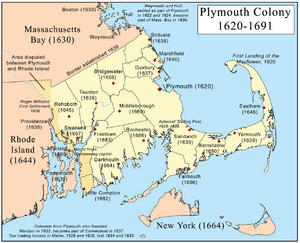
In 1641, the Plymouth Colony (at the time separate from the Massachusetts Bay Colony) purchased from the Indians a large tract of land which today includes the northern half of East Providence (from Watchemoket to Rumford), Rehoboth, Massachusetts, Seekonk, Massachusetts, and part of Pawtucket, Rhode Island. In 1645, John Brown of Plymouth bought a considerably smaller piece of land from the Indians, which today comprises the southern part of East Providence (Riverside), Barrington, Rhode Island, and a small part of Swansea, Massachusetts. Finally, in 1661, Plymouth completed the "North Purchase", from which Cumberland, Rhode Island, Attleboro, Massachusetts and North Attleborough, Massachusetts were later to be formed. The whole territory, which also included parts of modern Somerset, Massachusetts, and Warren, Bristol, and Woonsocket in Rhode Island, was at the time called "Rehoboth". The center of "Old Rehoboth" was within the borders of modern East Providence, Rhode Island.
By the 1650s, Massachusetts Bay, the Colony of Rhode Island (not yet unified with Providence) the Connecticut Colony, and two different land companies all claimed what is now Washington County, Rhode Island, what was referred to as Narragansett Country. Massachusetts Bay had conquered Block Island in 1636 in retaliation for the murder of a trader at the start of the Pequot War, and Massachusetts families settled there in 1661. The Plymouth Colony's land grant specified its western boundary as the Narragansett River; it is unclear whether this referred to the Pawcatuck River (on the current Connecticut-Rhode Island Border) or Narragansett Bay (much farther east, near the modern-day Rhode Island-Massachusetts border).
In 1663, Rhode Island obtained a patent extending its territory in certain places three miles east of Narragansett Bay. In 1664, a royal commission appointed by King Charles II of England denied the claims of Massachusetts and Plymouth to land west of Narragansett Bay, granting jurisdiction to the newly unified Colony of Rhode Island and Providence Plantations (pending resolution of the claims of Connecticut). However, the claims of Plymouth to all lands east of Narragansett Bay were upheld, and so the border was set in practice.
The 1691 charter unified Massachusetts Bay with Plymouth Colony (including Rehoboth) and said that the combined territory would extend as far south as "Our Collonyes of Rhode Island Connecticut and the Marragansett Countrey" (Narragansett Country).
In 1693 the monarchs William and Mary issued a patent extending Rhode Island's territory to three miles "east and northeast" of Narragansett Bay, conflicting with the claims of Plymouth Colony. This enlarged the area of conflict between Rhode Island and the Province of Massachusetts.
The issue was not addressed until 1740, when Rhode Island appealed to King George II of England. Royal commissioners from both colonies were appointed in 1741, and decided in favor of Rhode Island. The King affirmed the settlement in 1746 after appeals from both colonies. The royally approved three-mile boundary moved several towns on the eastern shore of Narragansett Bay (east of the mouth of the Blackstone River) from Massachusetts to Rhode Island.
This included what is now Bristol County, Rhode Island (the towns of Barrington, Bristol, and Warren), along with Tiverton, Little Compton, and Cumberland, Rhode Island (which was carved out of Attleborough, Massachusetts). East Freetown, which was left on the Massachusetts side of the border, was officially purchased by Freetown, Massachusetts, from Tiverton in 1747.
Commissioners from Rhode Island had the new boundary surveyed in 1746 (without consulting Massachusetts), based on six reference points, from each of which a distance was measured 3 miles inland. Massachusetts accepted this border until 1791, when its own surveyors found that the Rhode Island surveyors had "encroached" on Massachusetts territory by a few hundred feet in certain places. (Rhode Island disagreed.) Of particular concern was the boundary near Fall River, Massachusetts, which would later fall in the middle of a thickly settled area of high taxable value.
In 1812, after a court case involving the Massachusetts border, the western half of Old Rehoboth was set off as a separate township called Seekonk, Massachusetts, leaving the eastern part as Rehoboth, Massachusetts. Old Rehoboth's town center now became the heart of Old Seekonk.
In 1832, Rhode Island filed a case with the U.S. Supreme Court, but after six years of deliberations, it was dismissed. The court decided it did not have the jurisdiction to rule on the matter.
In 1844 and 1845, commissioners were once again authorized to survey and mark the boundary from Wrentham to the Atlantic Ocean, to address the inaccuracies of the 1746 survey. A report was issued in 1848, but the Massachusetts legislature refused to agree to the proposed solution, after being petitioned by residents of Fall River.
Both states filed bills of equity with the Supreme Court in 1852, and after more surveying and negotiation, a decree was issued on December 16, 1861. On March 1, 1862, when the Supreme Court ruling became effective, the western part of Old Seekonk (all of which was on the eastern shore of the Blackstone River) was ceded by Massachusetts and incorporated as East Providence, Rhode Island. Part of North Providence, Rhode Island was also combined with the former Pawtucket, Massachusetts and a sliver of Seekonk to form the modern Pawtucket, Rhode Island. A small amount of land was also added to Westport, Massachusetts. The southern boundary of Fall River, Massachusetts was moved from Columbia Street to State Avenue, expanding its territory. The Supreme Court made these adjustments not in conformance with King George's instructions, but to unify the thickly settled areas of Pawtucket and Fall River under the jurisdiction of a single state.
The 1861-2 boundary was slightly redefined in 1897, using stone markers instead of high-water levels. The physical survey was performed in 1898, and ratified by both states.
Rhode Island northern border
In 1710–11, commissioners from the Colony of Rhode Island and Providence Plantations and the Province of Massachusetts Bay agreed that the stake planted in 1642 by Nathaniel Woodward and Solomon Saffrey at Burnt Swamp Corner on the plains of Wrentham, Massachusetts, said to be at 41°55′N and thought to be three miles south of the southernmost part of the Charles River, would represent the starting point for the border.
The line extending west from the stake was surveyed in 1719, but inaccurately.
In 1748, Rhode Island appointed a commission to survey the line from the stake to the Connecticut border, but Massachusetts failed to send a delegation. The surveyors could not find the 1642 stake, and so marked a line from three miles south, by their reckoning, of "Poppatolish Pond" (presumably Populatic Pond, near Norfolk Airpark in Norfolk, Massachusetts). It was discovered that the Woodward and Saffrey stake was considerably farther south than three miles from the Charles River.
Rhode Island claimed that its commissioners had made a mistake in basing the border on the 1642 stake, and in 1832 filed a case with the Supreme Court of the United States. In 1846, the Court ruled in favor of Massachusetts. The same surveyors that marked the eastern boundary the previous year then marked the northern boundary, filing their report in 1848. Rhode Island accepted the markings as the legal boundary on the condition that Massachusetts do the same, but the Commonwealth failed to do so until 1865. But by that time, Rhode Island claimed that the 1861 Supreme Court case had changed matters so much as to render the "line of 1848" unacceptable.
Connecticut border
The town of Springfield was settled in 1636 by William Pynchon (as Agawam Plantation), encompassing the modern towns of Westfield, Southwick, West Springfield, Agawam, Chicopee, Holyoke, Wilbraham, Ludlow and Longmeadow in Massachusetts, and Enfield, Suffield, Somers, and East Windsor in Connecticut. It was connected to the Atlantic and major avenues of trade by the Connecticut River, which ran past Hartford and through the territory of the Connecticut Colony. Initially, Springfield's founders attended the Connecticut Colony meetings held in Hartford; however, relations quickly soured between the strong-minded leaders of each settlement, the iconoclastic William Pynchon of Springfield and Puritan Reverend Thomas Hooker of Hartford. Pynchon proved to be a very savvy businessperson, and his settlement quickly eclipsed the Connecticut towns in trade with the Natives. In 1640, during a grain shortage, Hooker and other Connecticut leaders gave Pynchon permission to buy grain for them; however, because the Natives were refusing to sell at reasonable prices, Pynchon refused the Natives' offers. Pynchon's perceived greediness infuriated Hartford; however, Pynchon explained that he was merely trying to keep market prices steady so that colonists need not pay exorbitant amounts in the future. Infuriated, Hartford sent Captain John Mason up to Pynchon's settlement "with money in one hand and a sword in the other." Mason threatened the Natives by Springfield with war if they did not sell grain at the prices he demanded. Pynchon was disgusted by this behavior, as he had enjoyed a congenial relationship with the Natives – and Mason's threats made him look bad. Mason believed that Natives were untrustworthy, and thus exchanged some "hard words" with Pynchon before leaving Springfield. After Mason left, settlers of Agawam Plantation rallied in support of Pynchon. In 1640, they voted to annex their settlement – with arguably the best position on the Connecticut River, near Enfield Falls, surrounded by fertile farmland and friendly Natives – to the faraway government in Boston, rather than the nearby government in Hartford. (Springfield had been settled by permission of the Massachusetts General Court, so Massachusetts assumed it had jurisdiction over Pynchon's settlement anyway; however, they renamed it Springfield in Pynchon's honor).
In 1641, Connecticut founded a trading post at Woronoke, which was in what was strongly considered to be Massachusetts territory (now Westfield). Massachusetts complained, and Connecticut demanded that Springfield pay taxes to support the upkeep of the fort at the mouth of the river, in the Saybrook Colony. Springfield's magistrate, William Pynchon, would have been amenable to the tax if Springfield could have representation at the fort at Saybrook; however, Connecticut refused Springfield's request for representation. Pynchon appealed to Boston, which responded to Connecticut by threatening to charge Connecticut traders for the use of the port of Boston, on which they were almost completely dependent.
To assert its sovereignty on the northern Connecticut River, the Massachusetts Bay Colony sent Nathaniel Woodward and Solomon Saffrey to survey and mark the boundary. They accidentally marked the boundary with Rhode Island significantly farther than the royally decreed three miles south of the southernmost part of the Charles River. Instead of traversing the territory of Massachusetts by land, they sailed around and up the Connecticut River, calculating the same latitude at which they had misplaced the stake on the Rhode Island border. This compounded the error even further, resulting in a four to seven mile discrepancy between where the border should have been and where it was marked, and awarding more territory to Massachusetts Bay than it had been granted by its charter. Though it was suspicious of this survey, Connecticut would not even receive a charter until 1662, and so the dispute would lie dormant for several decades.
The towns of Woodstock, Suffield, Enfield, and Somers were incorporated by Massachusetts, and mainly settled by migrants from the Massachusetts Bay and Plymouth Colonies. In 1686, Suffield and Enfield (incorporated in Massachusetts) were in a dispute over town territory with Windsor and Simsbury (incorporated in Connecticut, and which then included Granby). Massachusetts did not agree to a re-survey, so Connecticut hired John Butler and William Whitney to do the job. They found the southernmost part of the Charles River, and then traveled by land westward. Their 1695 report found that the 1642 line had been drawn too far south.
Consternation ensued. Abortive pleas to England were made in 1702. In 1713 a joint commission awarded control of Springfield-area towns to Massachusetts (without consulting the residents of those towns), compensating Connecticut with an equal amount of land further north. But the inhabitants of the Connecticut River border towns petitioned to be part of Connecticut in 1724, perhaps due to high taxes in Massachusetts or the greater civil liberties granted in the Connecticut charter.
In 1747, Woodstock petitioned the General Assembly of Connecticut to be admitted to the colony, on the grounds that the transfer of lands from Massachusetts in 1713 had not been authorized by The Crown. Suffield and Enfield soon followed, and the legislature accepted them in May 1749, and declared the 1713 compromise null and void. Massachusetts continued to assert sovereignty in practice.
In 1770, Southwick, Massachusetts was granted independence from Westfield, Massachusetts. In May 1774, residents in southern Southwick also petitioned Connecticut for entry and secession from northern Southwick, on the grounds they were south of the royally approved border of the Massachusetts Bay Colony (three miles south of the Charles River). The part west of Congamond Lake joined Simsbury, and the part east of the lake joined Suffield.
In 1791 and 1793, commissioners were sent from both states to survey the boundary line yet again, but were unable to agree until a compromise was reached in 1803–04. Massachusetts accepted the nullification of the 1713 compromise and the loss of the border towns, but regained the portion of southern Southwick west of the lake. This resulted in the modern boundary with Connecticut, which is a relatively straight east-west line, except for the "Southwick jog", a small, mostly rectangular piece of Massachusetts surrounded by Connecticut on three sides.
New York border
Massachusetts claimed all territory to the Pacific Ocean, based on its 1629 charter, but the Province of New York claimed the west bank of the Connecticut River (passing through Springfield, Massachusetts) as its eastern boundary, based on 1664 and 1674 grants to the Duke of York.
In 1773, the western boundary of Massachusetts was settled with the New York in its present location, and surveyed in 1787, following the line of magnetic north at the time. The starting point was a 1731 marker at the Connecticut–New York border, 20 miles inland from the Hudson River.
Massachusetts relinquished sovereignty over its western lands (east of the Great Lakes) to New York in the Treaty of Hartford in 1786, but retained the economic right to buy the Boston Ten Townships from Native Americans before any other party. These purchase rights were sold to private individuals in 1788. The Commonwealth also ceded its claim to far western lands (Michigan and all other land to the Pacific Ocean) to Congress in 1785.
In 1853, a small triangle of land in the southwest corner of the Commonwealth, known as Boston Corners, was ceded from Mount Washington, Massachusetts to Ancram, New York. The mountainous terrain made it difficult for Massachusetts authorities to enforce the law there, making the neighborhood a haven for outlaws and prize-fighters. Local residents petitioned for the transfer to allow New York authorities to clean up the hamlet.
Maine
From 1658 to 1820 Maine was an integral part of Massachusetts. In 1820, Maine was separated from Massachusetts (with its consent) and admitted into the Union as an independent state, as part of the Missouri Compromise. (See the History of Maine for information about its boundaries, including disputes with New Hampshire and Canadian provinces.)
Images for kids


